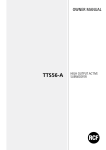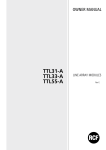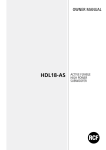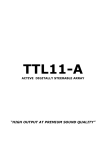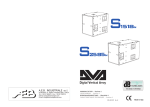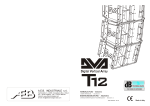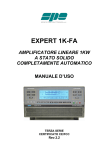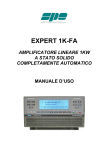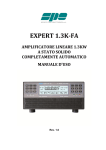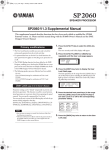Download TTS26-A MANUAL 1.0
Transcript
TTS26-A HIGH OUTPUT ACTIVE SUBWOOFER “HIGH OUTPUT AT PREMIUM SOUND QUALITY” We started the design of our TT+ speakers with a clear idea in mind: maximum high quality audio SPL in the smallest weight and size. Thanks to our state of the art neodymium transducers, premium quality analog processing and powerful class D amplifiers we reached and surpassed our original goals. IMPORTANT NOTES Before connecting and using the amplifier, please read this instruction manual carefully and keep it on hand for future reference. The manual is to be considered an integral part of the product and must accompany the amplifier when it changes ownership as a reference for correct installation and use as well as for the safety precautions. RCF Spa. will not assume any responsibility for the incorrect installation and/or use of the product.IANO WARNING: To prevent the risk of fire or electric shock, never expose this equipment to rain or humidity. SAFETY PRECAUTIONS 1. All the precautions, in particular the safety ones, must be read with special attention, as they provide important information. 2. The power supply voltage of this equipment is sufficiently high to involve a risk of electrocution; therefore, never install or connect the product with the power supply switched on. 3. Before powering up the amplifier, make sure that all the connections have been made correctly and that the voltage of your power mains corresponds to the voltage shown on the rating plate on the unit; if it does not, please contact your RCF dealer. 4. The metallic parts of the unit are earthed by means of the power cable. In the event that the current outlet used for power does not provide the earth connection, contact a qualified electrician to earth the equipment using the dedicated terminal. 5. To protect the power cable from damage, make sure that it is positioned so that it cannot be stepped on or crushed by objects. 6. To prevent the risk of electric shock, never open the amplifier. There are no parts on the inside that the user needs to access. 7. Make sure that no objects or liquids can get into the amplifier, as this may cause a short circuit. 8. Never attempt to carry out any operations, modifications, or repairs that are not expressly described in this manual. Contact your authorized service centre or qualified personnel should any of the following occur: - the amplifier does not function (or functions in an anomalous way); - the power supply cable has been damaged; - objects or liquids have got into the unit; - the amplifier has been subject to heavy impact. 9. When the amplifier is not to be used for long periods of time, switch it off and disconnect the power cable. 10. If the amplifier begins to emit any strange odours or smoke, switch it off immediately and disconnect the power supply cable. 11. Do not connect this product to any equipment or accessories not specified. For suspended installation, only use the dedicated anchoring points and do not try to hang this product using HANDLES or elements that are unsuitable or not specific for this purpose. Also check the suitability of the support surface to which the product is anchored (wall, ceiling, structure, etc.), and the components used for attachment (screw anchors, screws, brackets not supplied by RCF etc.), which must guarantee the security of the system/installation over time, also considering, for example, the mechanical vibrations normally generated by the transducer. To prevent the risk of falling equipment, do not stack multiple units of this product unless this possibility is specified in the instruction manual. 12. RCF Spa. strongly recommends this product is installed by professional qualified installers (or specialised firms) who can ensure correct installation and certify it according to the regulations in force. The entire audio system must comply with the current standards and regulations regarding electrical systems. 13. Supports and trolleys The equipment should only be used on trolleys or supports, where necessary, that are recommended by the manufacturer. The equipment/support/trolley assembly must be moved with extreme caution. Sudden stops, excessive pushing force and uneven floors may cause the assembly to overturn. 14. There are numerous mechanical and electrical factors to be considered when installing a professional audio system (in addition to those which are strictly acoustic, such as sound pressure, angles of coverage, frequency response, etc.). 15. Hearing loss Exposure to high sound levels can cause permanent hearing loss. The acoustic pressure level that leads to hearing loss is different from person to person and depends on the duration of exposure. To prevent potentially dangerous exposure to high levels of acoustic pressure, anyone who is exposed to these levels should use adequate protection devices. When a transducer capable of producing high sound levels is being used, it is therefore necessary to wear ear plugs or protective earphones. See the technical specifications in the instruction manual for the maximum sound pressure the loudspeaker is capable of producing IMPORTANT NOTES To prevent the occurrence of noise on the cables that carry microphone signals or line signals (for example, 0 dB), only use screened cables and avoid running them in the vicinity of: - equipment that produces high-intensity electromagnetic fields (for example, high power transformers); - mains cables; - lines that supply loudspeakers. OPERATING PRECAUTIONS - Do not obstruct the ventilation grilles of the unit. Situate this product far from any heat sources and always ensure adequate air circulation around the ventilation grilles. - Do not overload this product for extended periods of time. - Never force the control elements (keys, knobs, etc. ). - Do not use solvents, alcohol, benzene or other volatile substances for cleaning the external parts of this product. TT+ HIGH DEFINITION TOURING AND THEATRE RCF TT+ represents another prominent chapter in the long history of RCF Sound Systems. Whether a speaker system is designed for live sound or large concert situations as well as permanent installed theatre sound applications, the paying customer now expects a level of audio fidelity and intelligibility of such a standard unsurpassed by previous generations. This requirement has fostered the need for Audio Professionals to be able to offer a range of speaker systems combined with dedicated Processing and Amplification Technologies that are superior in Acoustic Performance and Control Technology. RCF TT+ offers ready to use solutions and tools in true active high definition speaker systems. INNOVATION INTEGRATION INTENSITY INNOVATION. Our research and engineering faculty can today offer innovative projects with finite control of each detail, from the loudspeaker voice coil wire to the highly efficient extended dynamic amplifier topology. There are many different ingredients that go into creating quality products and systems. These include computer aided simulation software to assist the understanding of transducer behaviour and amplifier operation and the relationship of dynamics and transient response. RCF utilise over thirty state of the art software packages to identify magnetic circuits, voice coil dynamics, suspension linearity, horn dispersion simulation, crossover filters, amplifier thermal behaviour etc. INTEGRATION. RCF is one of only a few loudspeaker manufacturers worldwide who have the ability to completely design and manufactures transducers, speaker systems and amplification and control electronics. Our 50 plus years heritage in Audio combined with our state of the art research and development and manufacturing processes allows us to seamlessly integrate all the ingredients to design and build TT+ INTENSITY. The design philosophy for the new TT+ series is based upon offering the sound engineer solutions and tools that are ready to use. Key factors are the ability to sustain very high power with highly efficient sound pressure levels. Intense sound levels are created with extremely high definition and extended dynamic range. Modern construction materials result in mechanical weight ratios that are light for practical flying and portability. TTS26-A, HIGH OUTPUT SUBWOOFER The TTS26-A is a high power, high output active subwoofer system that sets a new standard in the touring and theatre sound reinforcement. Each transducer has been specifically designed for the application. The woofer provides large excursion and very light weight. The TTS26-A two 15” woofers features: - lightweight, high force, neodymium magnet assembly - 100 mm diameter, 25 mm length, inside-outside copper voice coil - silicon reinforced double spiders - Kevlar fiber doped, water resistant treated cone - complex ventilation system for minimum power compression The TTS26-A input section provides: - In/Out XLR connectors - Crossover Output XLR connector - System sensitivity control (linear potentiometer) (-2 dBu ~ +10 dBu) - Crossover set-up (90 Hz – 150 Hz) - Low frequencies high pass set-up (30 Hz - 45 Hz) - Delay set-up rotary switch - Cardioid set-up switch By-pass switch RDNet input output Ethercon connectors 4 status LEDs The TTS26-A amplifier section features: - 3400 Watt Digital amplifier modules with PFC circuit System cooling speed controlled fans Powercon AC input- output connectors Vibrostop floating aluminum panel REAR PANEL FEATURES AND CONTROLS 1 2 3 4 5 6 7 8 9 MAIN SIGNAL XLR INPUT (BAL/UNBAL). The system accept female XLR input connectors and linelevel signals from a mixing console or other signal source. SIGNAL LINK XLR OUTPUT. The output XLR male connector provides a loop trough for speakers daisy chaining. XOVER SIGNAL OUTPUT. The output XLR male connector provides a crossover high passed signal (24 dB/octave) for satellites speakers. INPUT SENSITIVITY. Controls the overall signal level at the input to the power amplifier. The control ranges from + 10 dBu (maximum attenuation) to the –2 dBu sensitivity (maximum input gain). The centre detent is +4 dBu (nominal level required to drive the amplifier at maximum power). XLOW CUT 30/45 Hz. This switch provides an high pass 24 dB/octave filtering at 30 or 45 Hz. This is really useful for indoor situations (no very low frequencies that can create resonant sound) or when all the power shall be used in the 45 Hz – 150 Hz range. XOVER 90/150 HZ. Provides 24 dB/octave low-pass filtering at 90 Hz if released, at 150 Hz if pressed. The same crossover frequency in high-pass is available from XOVER OUTPUT XLR. TIME DELAY ENCODER. This encoder provides a time delay setting expressed in meters. TIME DELAY DISPLAY. Display the time delay setting. POWER INDICATOR. Power on indicator. When the power cord is connected and the power switch is turned on this indicator lights green. 10 STATUS INDICATOR. The status indicator blink orange if the main amplifier or power supply is in faulty condition. If the status indicator lights orange, switch off the amplifier and call the closest RCF SERVICE CENTRE. 11 SIGNAL INDICATOR. The signal indicator lights green if there is signal present on the main XLR input. 12 LIMITER INDICATOR. The amplifier has a built in compressor/limiter circuit to prevent clipping of the amplifiers or overdriving the transducers. When the compressor is active the led is blinking yellow. When the soft clipping circuit is active the LED blinks orange. It is okay if the limit LED blinks occasionally. If the LED blinks frequently or lights continuously, turn down the signal level. The amplifier has a built in RMS limiter. If the RMS limiter is active the LED lights red. The RMS limiter has the purpose to prevent damages the transducers. The speaker shall never be used with the limit indicator red, continuously. Continuous operation with the RMS protection active can cause damages to the speaker. 13 CARDIOID SET-UP SWITCH. This switch provides a special equalisation and delay setting to create a cardioid pattern when the system is used in conjunction with two other TTS56-A modules. 14 BY PASS SWITCH. Pressing this switch it is possible to by-pass the RDNet user setting preloaded on the module. 15 DATA INPUT ETHERCON CONNECTOR. RDNet Input CAT5 Ethercon connector. 16 DATA LINK ETHERCON CONNECTOR. RDNet Link CAT5 Ethercon connector. 17 LINK LED. This green led is on if the module is addressed from the RDNet controller 18 ACTIVE LED. This green led is blinking if the RDNet communication is active. 19 POWER MAIN SWITCH. The power switch turns the AC power ON and OFF. Make sure that the sensitivity is set to + 10 dBu when you turn on the speaker. 20 AC POWERCON RECEPTACLE. RCF TT+ series uses a POWERCON locking 3-pole AC mains. Always use the specific power cord provided in the package. CONNECTIONS The XLR connectors use the following AES standard: PIN 1 = GROUND (SHIELD) PIN 2 = HOT (+) PIN 3 = COLD (-) BEFORE TURNING ON THE SPEAKER At this point you can connect the power supply cable and the signal cable, but before turning on the speaker make sure that the volume control is at the minimum level (even on the mixer output). It is important that the mixer is already ON before turning on the speaker. This will avoid damage to the speakers and noisy “bumps” due to turning on parts on the audio chain. It is a good practice to always turn on speakers at last and turn them off immediately after the show. Now you can turn ON the speaker and adjust the volume control to a proper level. TIME DELAY SETTING The delay is expressed in meters. The delay resolution is 0.1 up to 10 meters and 1 from 10 to 20 meters. To set the system time delay push the delay encoder and rotate it until the wanted setting is displayed. Push the encoder again to confirm the setting. CARDIOID SET-UP It is possible to create subwoofer cardioid systems using groups of three modules. A group is made of three modules, the group shall be made as follow: - 2 modules pointing in forward direction, cardioid switch released - 1 module pointing in backward direction, cardioid switch pressed - all 3 modules shall have the same settings (system delay, sensitivity, x-low cut, x-over,…). RDNet CONNECTION The system is equipped with an RDNet connection on board. Using an RDNet controller unit it is possible to: - receive status information from the system ( amplifiers status, signal levels, system settings,…) - send commands to the system (mute, solo, change sensitivity, change setting, set user eq, … ) See the RDNet user manual for details. RDNet BY-PASS SWITCH When the RDNet is present and the RDNet LINK LED is green the controller takes control over the module independently of the BY-PASS SWITCH position When the RDNet is not present, the BY-PASS switch act as follow: - BY-PASS SWITCH pressed (LED ON): The system bypass the input board and reads the RDNet user settings (last configuration saved). - BY-PASS SWITCH released (LED OFF): The system reads the input board and bypass the user setting eventually loaded ion the speaker (last configuration eventually saved). TTS26-A DEFAULT CONFIGURATION The TTS26-A factory default configuration (the configuration that the system reads if the BY-PASS switch is pressed) is the following: Sensitivity High pass Low pass Cardioid Delay Bypass User filters +4 dBu 30 Hz 150 Hz OFF 0 OFF ALL FLAT If the user set with RDNet a new configuration, the new configuration will be recalled when the BY-PASS switch is pressed. BY-PASS SWITCH RDNet BY-PASS LED FUNCTION ON OFF ON OFF ON ON OFF OFF ON OFF ON OFF Reads RDNet settings Reads RDNet settings Reads last saved used configuration Reads input panel TRANSPORTATION The subwoofer system is equipped with 4 x 100 mm blue rubber wheels on the back of the cabinet for transportation Two aluminium die cast handles with rubber hand-grip are available on each side of the speaker system. The outdoor quality, Baltic birch plywood, cabinet is protected with heavy duty, scratch resistant, polyurea coating. INSTALLATION The TTS26-A active subwoofer features: - top pole mount cap for professional 35 mm speaker pole mount top plates to assembly a TTL11-A system on top of a TTS26-A subwoofer WARNING: Never suspend TT+ speakers by there handles. Handles are intended for transportation, not for rigging. WARNING: Always make sure that the maximum current requirement does not exceed the maximum admitted POWERCON current. In case of doubt call the closest RCF SERVICE CENTRE. MAINS SUPPLY The system accept mains supply voltage115-230 (+15/-15%) V ~ TTS26-A FUSE F1 FUSE F2 FUSE F3 VALUE F15 AL 250 V ~ VALUE T 10 AL 250 V ~ VALUE T 10 AL 250 V ~ TTS26-A ACCESSORIES 13360138 AC POWER CABLE 6XTTL55 POWER CABLE 1 piece for EVERY 6 pieces OF TTS26 SUB are suggested. – Full compatibility with Socapex SL 419 Series 13360145 AC POWER BOX 6XTTL55 EUROPEAN STAGE BOX TO POWER 6 TTL55-A LINE ARRAY MODULES OR 6 TTS56-A MODULES 1 piece for 6 pieces OF TTS26 SUB are suggested. – Full compatibility with Socapex SL 419 Series 13360146 AC POWER EXTENSION TTL55 POWER EXTENSION CABLE 20 meters AC power extension cable – Full compatibility with Socapex SL 419 Series IMPORTANTE. Prima di collegare ed utilizzare questo prodotto, leggere attentamente le istruzioni contenute in questo manuale, il quale è da conservare per riferimenti futuri. Il presente manuale costituisce parte integrante del prodotto e deve accompagnare quest’ultimo anche nei passaggi di proprietà, per permettere al nuovo proprietario di conoscere le modalità d’installazione e d’utilizzo e le avvertenze per la sicurezza. L’installazione e l’utilizzo errati del prodotto esimono la RCF S.p.A. da ogni responsabilità. ATTENZIONE: Per prevenire i rischi di fiamme o scosse elettriche, non esporre mai questo prodotto alla pioggia o all'umidità (salvo il caso in cui sia stato espressamente progettato e costruito per l’uso all’aperto). AVVERTENZE PER LA SICUREZZA 1. Tutte le avvertenze, in particolare quelle relative alla sicurezza, devono essere lette con particolare attenzione, in quanto contengono importanti informazioni. 2. ALIMENTAZIONE DA RETE. La tensione di alimentazione dell’apparecchio ha un valore sufficientemente alto da costituire un rischio di folgorazione per le persone: non procedere mai all’installazione o connessione dell’apparecchio con l’alimentazione inserita. Prima di alimentare questo prodotto, assicurarsi che tutte le connessioni siano corrette e che la tensione della vostra rete di alimentazione corrisponda quella di targa dell’apparecchio, in caso contrario rivolgetevi ad un rivenditore RCF. Le parti metalliche dell’apparecchio sono collegate a terra tramite il cavo di alimentazione. Nel caso la presa di corrente utilizzata per l’alimentazione non fornisca il collegamento con la terra, contattare un elettricista qualificato, che provvederà a connettere a terra l’apparecchio tramite l’apposito morsetto. Accertarsi che il cavo di alimentazione dell’apparecchio non possa essere calpestato o schiacciato da oggetti, al fine di salvaguardarne la perfetta integrità. Per evitare il rischio di shock elettrici, non aprire mai l’apparecchio: all’interno non vi sono parti che possono essere utilizzate dall’utente. 3. Impedire che oggetti o liquidi entrino all’interno del prodotto, perché potrebbero causare un corto circuito. 4. Non eseguire sul prodotto interventi / modifiche / riparazioni se non quelle espressamente descritte sul manuale istruzioni. Contattare centri di assistenza autorizzati o personale altamente qualificato quando: - l’apparecchio non funziona (o funziona in modo anomalo); - il cavo di alimentazione ha subito gravi danni; - oggetti o liquidi sono entrati nell’apparecchio; - l’apparecchio ha subito forti urti. 5. Qualora questo prodotto non sia utilizzato per lunghi periodi, togliere la tensione dal cavo di alimentazione (o scollegare l’alimentatore esterno). 6. Nel caso che dal prodotto provengano odori anomali o fumo, spegnerlo immediatamente e togliere la tensione dal cavo di alimentazione (o scollegare l’alimentatore esterno). 7. Non collegare al prodotto altri apparecchi e accessori non previsti. Quando è prevista l’installazione sospesa, utilizzare solamente gli appositi punti di ancoraggio e non cercare di appendere questo prodotto tramite elementi non idonei o previsti allo scopo. Verificare inoltre l’idoneità del supporto (parete, soffitto, struttura ecc., al quale è ancorato il prodotto) e dei componenti utilizzati per il fissaggio (tasselli, viti, staffe non fornite da RCF ecc.) che devono garantire la sicurezza dell’impianto / installazione nel tempo, anche considerando, ad esempio, vibrazioni meccaniche normalmente generate da un trasduttore.Per evitare il pericolo di cadute, non sovrapporre fra loro più unità di questo prodotto, quando questa possibilità non è espressamente contemplata dal manuale istruzioni. 8. La RCF S.p.A. raccomanda vivamente che l’installazione di questo prodotto sia eseguita solamente da installatori professionali qualificati (oppure da ditte specializzate) in grado di farla correttamente e certificarla in accordo con le normative vigenti. Tutto il sistema audio dovrà essere in conformità con le norme e le leggi vigenti in materia di impianti elettrici. 9. Sostegni e Carrelli. Se previsto, il prodotto va utilizzato solo su carrelli o sostegni consigliati dal produttore. L’insieme apparecchio-sostegno / carrello va mosso con estrema cura. Arresti improvvisi, spinte eccessive e superfici irregolari o inclinate possono provocare il ribaltamento dell’assieme. 10. Vi sono numerosi fattori meccanici ed elettrici da considerare quando si installa un sistema audio professionale (oltre a quelli prettamente acustici, come la pressione sonora, gli angoli di copertura, la risposta in frequenza, ecc.). 11. PERDITA DELL’UDITO. L’esposizione ad elevati livelli sonori può provocare la perdita permanente dell’udito. Il livello di pressione acustica pericolosa per l’udito varia sensibilmente da persona a persona e dipende dalla durata dell’esposizione. Per evitare un’esposizione potenzialmente pericolosa ad elevati livelli di pressione acustica, è necessario che chiunque sia sottoposto a tali livelli utilizzi delle adeguate protezioni; quando si fa funzionare un trasduttore in grado di produrre elevati livelli sonori è necessario indossare dei tappi per orecchie o delle cuffie protettive. Consultare i dati tecnici contenuti nel manuale istruzioni per conoscere la massima pressione sonora che il diffusore acustico è in grado di produrre. NOTE IMPORTANTI Per evitare fenomeni di rumorosità indotta sui cavi che trasportano segnali dai microfoni o di linea (per esempio 0dB), usare solo cavi schermati ed evitare di posarli nelle vicinanze di apparecchiature che producono campi elettromagnetici di forte intensità (per esempio trasformatori di grande di potenza), cavi di rete, linee che alimentano altoparlanti. PRECAUZIONI D’USO - Non ostruire le griglie di ventilazione dell'unità. Collocare il prodotto lontano da fonti di calore e garantire la circolazione dell’aria in corrispondenza delle griglie di aerazione. - Non sovraccaricare questo prodotto per lunghi periodi. - Non forzare mai gli organi di comando (tasti, manopole ecc.). - Non usare solventi, alcool, benzina o altre sostanze volatili per la pulitura delle parti esterne dell'unità. TT+ HIGH DEFINITION TOURING AND THEATRE RCF TT+ rappresenta un altro importante capitolo della lunga storia di RCF. Sia che i diffusori siano progettati per musica dal vivo, per concerti in grandi spazi o per l’installazione fissa in teatri, il cliente si aspetta un livello di fedeltà e di intelligibilità decisamente superiore a quella degli impianti di precedente generazione. Questa esigenza ha fatto si che i professionisti del settore audio sentissero la necessità di offrire un’ampia gamma di diffusori acustici abbinata a tecnologie di elaborazione ed amplificazione con prestazioni acustiche e di controllo di qualità superiore. RCF TT+ offre soluzioni e strumenti di immediato utilizzo nel campo dei diffusori attivi ad alta definizione. INNOVAZIONE, INTEGRAZIONE, INTENSITÀ INNOVAZIONE – Il nostro team di ricerca e sviluppo è in grado di offrire progetti innovativi con controllo di ogni dettaglio, dal rame smaltato di avvolgimento della bobina dell’altoparlante fino alla topologia ad elevata efficienza dell’amplificatore a dinamica estesa. Sono molti gli ingredienti che contribuiscono a creare prodotti e sistemi di qualità, tra questi i software di simulazione computerizzata che aiutano a comprendere il comportamento dei trasduttori ed il funzionamento dell’amplificatore, oltre allo studio della risposta dinamica e della risposta ai transienti. RCF utilizza oltre trenta software per lo studio di circuiti magnetici, dinamica delle bobine, linearità delle sospensioni, simulazione della dispersione delle trombe, filtri crossover, comportamento termico dell’amplificatore, ecc. INTEGRAZIONE - RCF è uno dei pochi produttori di altoparlanti al mondo in grado di elaborare completamente i progetti e di costruire trasduttori, diffusori, elettronica d’amplificazione e controllo. La nostra esperienza di oltre 50 anni nel settore audio abbinata ai nostri avanzati processi di ricerca e sviluppo nonché di produzione, ci permette di integrare perfettamente tutti gli ingredienti che compongono il sistema TT+. INTENSITÀ– La filosofia progettuale della nuova serie TT+, si basa sulla volontà di offrire soluzioni tecniche e strumenti acustici di immediato utilizzo. Fattori chiave sono la capacità di sostenere elevati livelli di potenza e di pressione sonora con grande efficienza. Intensi livelli sonori sono riprodotti con una definizione estremamente elevata ed estesa dinamica. I materiali high tech con i quali è costruita la serie TT+ permettono di ottenere un peso complessivo molto basso facilitando quindi sospensione e trasporto. ALTI LIVELLI E GRANDE QUALITÀ ACUSTICA Abbiamo avviato la progettazione dei diffusori compatti della serie TT+ con un’idea chiara in mente: la massima pressione sonora con elevatissima qualità audio, il minor peso e le più piccole dimensioni. Con i nostri avanzatissimi trasduttori al neodimio, l’elaborazione analogica d’eccellente qualità ed i potenti amplificatori in classe D abbiamo raggiunto e superato i nostri obiettivi iniziali. Il TTS26-A è un subwoofer attivo professionale ad alta potenza che definisce un nuovo standard nel rinforzo sonoro touring. I trasduttori sono stati progettati in modo specifico per l’applicazione, sono dotati di elevata escursione e pesi estremamente contenuti. I woofer del sistema TTS26-A hanno le seguenti caratteristiche: - Circuito magnetico in neodimio, ad alta energia e dal peso contenuto - Bobina in rame, interno-esterno di 100 mm di diametro e 25 mm di lunghezza - Sospensioni doppie al silicone - Cono caricato con fibre di kevlar e trattamento resistente all’acqua - Doppio sistema di ventilazione per garantire la minima compressione acustica alla massima potenza La sezione ingressi è dotata di: - Connettori In/Out XLR - Connettore XLR Crossover Out - Potenziometro lineare per variare la sensibilità (-2 dBu - +10 dBu) - Selezione del crossover (90 Hz – 150 Hz) Selezione del filtro passa alto (30 Hz - 45 Hz) Selettore rotativo per l’assegnazione del ritardo temporale Selettore per la selezione della configurazione cardioide Selettore di by-pass delle impostazioni RDNet Connettori di ingresso ed uscita RDNet 4 LED di stato La sezione di amplificazione del TTS26-A è dotata di: - amplificatore digitale da 3400 Watt - circuito di alimentazione dotato di circuito di correzione PFC - connettore di alimentazione in/out Powercon - meccanica in alluminio sospesa con Vibrostop CARATTERISTICHE E CONTROLLI DEL PANNELLO POSTERIORE 1 2 3 4 5 6 7 8 INGRESSO XLR SEGNALE AUDIO (BAL/UNBAL). Il sistema accetta connettori di ingresso XLR femmina e segnali a livello linea da mixer o da alter sorgenti di segnale. USCITA XLR SEGNALE AUDIO . L’uscita XLR maschio provvede una connessione in uscita del segnale audio per connettere più diffusori allo stesso segnale. USCITA XOVER SEGNALE AUDIO. Il connettore XLR maschio fornisce un uscita audio passa-alto (24 dB/ottava) per diffusori satellite. SENSIBILITA’ IN INGRESSO. Controlla il livello del segnale in ingresso all’amplificatore di potenza. Il controllo varia da +10 dBu (massima attenuazione) alla sensibilità –2 dBu (massimo guadagno in ingresso). La sensibilità nella posizione centrale è +4 dBu (livello nominale richiesto per ottenere la massima potenza dagli amplificatori). XLOW CUT. Questo pulsante fornisce al sistema un filtro passa alto (24 dB/ottava a 45 hertz). Può essere molto utile per situazioni indoor, dove le frequenze molto basse possono provocare onde stazionarie e perdita di intelligibilità del sistema. Può essere usato anche quando si vuol concentrare tutta la potenza dell’amplificatore nella banda 45 Hz – 150Hz. XOVER 90/150 HZ. Questo pulsante fornisce una frequenza di crossover ad 90 Hz se rilasciato, a 150 Hz se premuto. La stessa frequenza di crossover è disponibile per il satellite all’uscita di segnale audio XOVER OUTPUT XLR. ENCODER RITARDO TEMPORALE. Permette l’impostazione del ritardo temporale in metri. DISPLAY RITARDO TEMPORALE. Indica il ritardo settato sul modulo espresso in metri. 9 10 11 12 13 14 15 16 17 18 19 20 POWER INDICATOR. Indicazione di alimentazione presente. Quando il diffusore è connesso alla rete e l’interruttore in posizione ON il led si accende con colore VERDE. STATUS INDICATOR. L’indicatore di stato si accende con colore ARANCIONE se l’amplificatore principale evidenzia un malfunzionamento. Nel caso in cui il led STATUS si accenda spegnere e scollegare l’apparecchio e rivolgersi al CENTRO ASSISTENZA RCF più vicino. SIGNAL INDICATOR. Il led di segnale si accende con colore VERDE se è presente segnale audio all’ingresso XLR. LIMIT INDICATOR. L’amplificatore è dotato di un circuito di compressore/limiter in modo da prevenire il clipping dell’amplificatore o di sovrapilotare gli altoparlanti. Quando il circuito di compressione è attivo il LED lampeggia con colore giallo. Quando il circuito di soft clipping è attivo il LED lampeggia con colore ARANCIONE. E’ accettabile che il LED lampeggi occasionalmente. Se il LED lampeggia frequentemente o si accende di continuo ridurre il segnale in ingresso. L’amplificatore è dotato di un circuito di limiter RMS. Il limiter RMS serve a proteggere i trasduttori. Se il circuito di protezione RMS è attivo il LED si accende con colore ROSSO. Il diffusore non deve mai essere utilizzato con il LED ROSSO acceso in modo continuo, operare a lungo con il led rosso acceso può causare danni al diffusore. PULSANTE CARDIOID SET-UP. Questo pulsante, una volta premuto, attiva una equalizzazione ed un ritardo temporale del modulo atti a creare un sistema cardioide utilizzando gruppi di 3 subwoofers. PULSANTE BY PASS. Premendo questo pulsante è possibile by-passare le impostazioni utente precaricate sul modulo. CONNETTORE DATA INPUT ETHERCON. Connettore RDNet Input CAT5 Ethercon. CONNETTORE DATA LINK ETHERCON. Connettore RDNet Link CAT5 Ethercon. LINK LED. Questo LED si illumina verde quando il modulo è indirizzato da un controller RDNet. ACTIVE LED. Questo LED lampeggia verde quando la comunicazione RDNet è attiva. INTERRUTTORE DI ALIMENTAZIONE. L’ interruttore apre e chiude l’alimentazione in corrente AC. Assicurarsi che la sensibilità sia +10 dBu quando si accende il diffusore. PRESA AC POWERCON. La serie RCF TT+ utilizza connettori AC POWERCON . Utilizzare sempre i cavi rete forniti a corredo CONNESSIONI Il connettore di ingresso XLR segue il seguente standard AES: PIN 1 = TERRA (GROUND ; SHIELD) PIN 2 = LATO CALDO (HOT ; +) PIN 3 = LATO FREDDO (COLD ; -) PRIMA DI ACCENDERE IL DIFFUSORE A questo punto potete inserire il connettore di alimentazione e il connettore di segnale, ma prima di accendere il diffusore assicuratevi che il controllo di volume sia al minimo sia sul diffusore che sulla sorgente sonora collegata al diffusore (che generalmente sarà un mixer); è importante anche che il mixer sia già acceso al momento in cui viene acceso il diffusore a lui collegato. Queste due precauzioni vi eviteranno innanzitutto di accendere i diffusori in presenza di forti segnali in ingresso (evitando di causare danni al diffusore stesso ma soprattutto alle persone che vi si possono trovare davanti) e inoltre di far arrivare agli altoparlanti e al pubblico i fastidiosi “bump” causati dall’accensione delle apparecchiature audio a monte dei diffusori. Infatti è buona regola che i diffusori amplificati e gli amplificatori in genere siano sempre le ultime apparecchiature ad essere accese dopo il montaggio e le prime ad essere spente alla fine dello spettacolo. A questo punto potete accendere il diffusore e alzare il controllo di livello a seconda delle necessità. IMPOSTAZIONE DEL RITARDO TEMPORALE (TIME DELAY) Il ritardo è espresso in metri. Le risoluzione del ritardo è di 0.1 fino a 10 metri ed 1 da 10 a 20 metri. Per impostare il ritardo premere l’encoder e successivamente ruotarlo sino a raggiungere il ritardo desiderato. Premere nuovamente l’encoder per confermare l’impostazione. IMPOSTAZIONE DELLA FUNZIONE CARDIOIDE (CARDIOID) E’ possibile creare sistemi cardioide utilizzando gruppi di subwoofers. Un gruppo è costituito di tre moduli disposti come segue: - 2 moduli rivolti nella direzione di propagazione, pulsante cardioid rilasciato - 1 modulo rivolto nella direzione opposta alla propagazione, pulsante cardioid inserito - tutti i 3 moduli devono avere le medesime impostazioni generali (ritardo, sensibilità, xover,…) CONNESSIONE RDNet Il sistema è dotato di connessione RDNet. Utilizzando un controller RDNet è possibile: - ricevere informazioni di stato del sistema (stato degli amplificatori, dei segnali, delle impostazioni,…) - inviare comandi al sistema (mute, solo, variazioni di livello, di impostazioni,…) Riferirsi al manuale utente RDNet per maggiori dettagli. PULSANTE RDNet BY-PASS Quando RDNet è presente ed il LED RDNet LINK è verde il controller ha il controllo del modulo e dei sui ingressi indipendentemente dalla posizione del tasto. Quando RDNet non è presente, il tasto BY-PASS agisce come segue: - TASTO BY-PASS premuto (LED ON): Il sistema by-passa la scheda ingressi e legge la configurazione utente impostata da RDNet (ultima configurazione salvata). - TASTO BY-PASS rilasciato (LED OFF): Il sistema legge la scheda ingressi e bypassa lea configurazione utente eventualmente caricata sul modulo (ultima configurazione eventualmente salvata). CONFIGURAZIONE DI DEFAULT TTS26-A La configurazione di default del modulo TTS56-A (la configurazione che viene letta se RDNet non è presente ed il pulsante by-pass è premuto) è la seguente: Sensitivity High pass Low pass Cardioid Delay Bypass User filters Sensibilità Passa alto Passa basso Cardioide Ritardo By-pass Filtri utente +4 dBu 30 Hz 150 Hz OFF 0 OFF ALL FLAT Nel caso in cui l’utente setti tramite RDNet una nuova configurazione, la nuova configurazione verrà richiamata quando il tasto BY-PASS è premuto. BY-PASS SWITCH RDNet BY-PASS LED FUNCTION ON OFF ON OFF ON ON OFF OFF ON OFF ON OFF Reads RDNet settings Reads RDNet settings Reads last saved used configuration Reads input panel TRASPORTO Il subwoofer è dotato di 4 ruote in gomma per il trasporto di diametro 100 mm posizionate sul lato posteriore del diffusore. Sono disponibili su ogni lato del diffusore 2 maniglie pressofuse in alluminio con impugnatura in gomma. Il mobile, realizzato in multistrato di betulla per uso da esterno, è rivestito da una robusta protezione antigraffio in polyurea. INSTALLAZIONE DEL DIFFUSORE Il subwoofer attivo TTS26-A presenta: - Inserto a tazza per asta professionale in acciaio da 35 mm Piastre per l’installazione di un sistema TTL11-A sopra ad un sub TTS26-A ATTENZIONE: Non sospendere mai il diffusore per mezzo delle maniglie. Le maniglie sono state progettate per il trasporto del diffusore, non per la sua sospensione. ATTENZIONE: Assicurarsi sempre che la richiesta massima di corrente non superi la corrente massima ammessa dai connettori POWERCON. In caso di dubbio contattare il CENTRO ASSISTENZA RCF più vicino. TENSIONE DI ALIMENTAZIONE Il sistema accetta una tensione di alimentazione di 115-230 (+15/-15%) V ~ TTS26-A FUSIBILE F1 FUSIBILE F2 VALORE VALORE F15 AL 250 V ~ T 10 AL 250 V ~ FUSIBILE F3 VALORE T 10 AL 250 V ~ ACCESSORI DEL SUBWOOFER TTS56-A I seguenti accessori sono separatamente disponibili: 13360138 AC POWER CABLE 6XTTL55 POWER CABLE 1pezzo ogni 6 moduli di TTS26-A. Completa compatibilità con Socapex Serie SL 419. 13360145 AC POWER BOX 6XTTL55 STAGE BOX EUROPEO PER ALIMENTARE 6 TTL55-A O 6 TTS56-A 1pezzo ogni 6 moduli di TTS26-A. Completa compatibilità con Socapex Serie SL 419. 13360146 AC POWER EXTENSION TTL55 CAVO DI ESTENSIONE DELL’ALIMENTAZIONE Cavo di estensione dell’alimentazione di lunghezza 20 metri – Completa compatibilità con Socapex Serie SL 419. TTS26-A TECHNICAL SPECIFICATIONS ACOUSTICAL TT26-A Operating frequency range Max SPL Crossover point 35 – 120 Hz 140 dB 90 Hz/ 150 Hz TRANSDUCERS Low frequency 2 x 15” neodymium woofer, 4.0” voice coil 3400 Watt digital amplifier PFC switching power supply Sensitivity Control (-2 dBu ~ 10 dBu) X-low cut, X-over selection Delay set-up Cardioid setting, RDNet bypass User settings (RDNet) AMPLIFIERS CONNECTIONS Signal Input/Output Power Input/Output RDNet Input/Output XLR male/female Powercon male/female Cat5 Ethercon CONTROLS DSP Controls DSP PROCESSING High pass, low pass, equalisation Crossover output processing Fast limiter, dynamic compressor RMS limiter PHISICAL Size Weight Cabinet material Hardware 460 x 900 x 700 mm 56 Kg Baltic birch plywood 4 x die cast handles TTL11-A mounting plates.





















